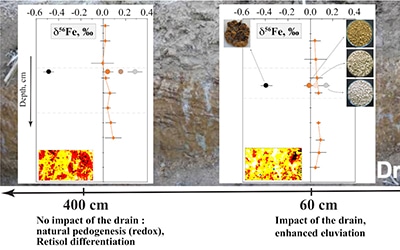Applications Soil Preparation & Analysis
We use our equipment to process soil samples, but also organic and inorganic matrices used in agriculture such as fertilisers or pesticides (organic waste, fungicides, etc.), samples of industrial and mining residues, geological samples or, occasionally, archaeological artefacts.
The work focuses on the evolution of soils under external, natural or anthropogenic pressure and addresses processes and mechanisms at different scales, from mineral to soil sequence.

Study the evolution of soil horizons impacted by human activity
E.g. Observation of iron isotope fractionations recording the evolution of the horizons of a drained Albeluvisol over 16 years. The graphs show the isotopic contrast between the total soil, whose isotopic composition is very homogeneous over the entire profile (orange diamonds linked together), and the soil features (black, orange, brown and beige dots), which show a wide isotopic variability and which also change according to the distance from the drain. The iron isotopes allowed us to identify the precipitation of iron and manganese oxides as the main fractionating process.
r

